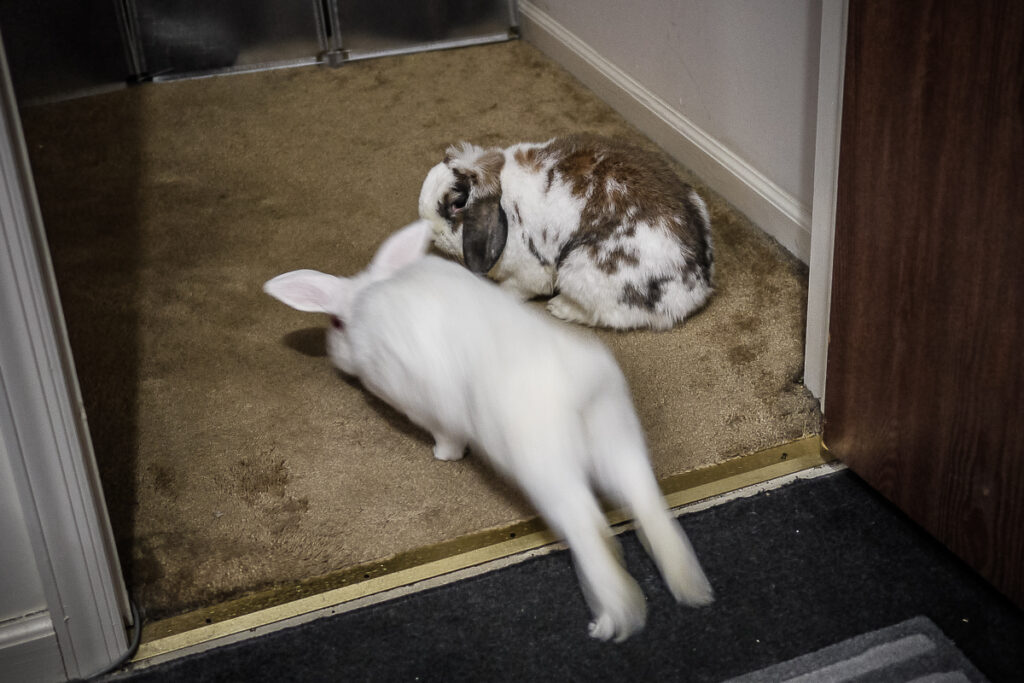Attention deficit disorder (ADD) is a fashionable diagnosis in these information-saturated times. Like popular maladies of earlier periods–.e.g., neuralgia, hysteria–ADD tells us much about today’s world. We must choose, and choose carefully, where and on whom to focus our attention and our love. The more lives you pay attention to, the more you learn about those particular lives and about the craft of paying attention.
DIFFERENT HABITS FOR DIFFERENT RABBITS
Barney is an adventurous soul. He’ll follow pools of sunlight from the bedroom to the living room. On cloudy days and at dusk, he may be found under the piano, or behind the sofa. When he’s feeling frisky, he will chase one of the cats until she leaps to safety on a kitchen counter or the shelf above the fireplace. Barney’s friend Boz lives in a world approximately eight feet square. In that space he has three companions (including Barney); several canine and feline visitors; a succession of cardboard boxes for chewing on and hiding in; 3 litterboxes, which he occasionally uses for their intended purpose; a cage; and of course, food and water. Boz could, if he chose, accompany Barney on his forays. Barney could, if he wished, stay with Boz, Martha, and Iris in their home territory.
What do Barney and Boz have in common, other than their home base? What, in fact, do they share with every creature of every species with whom they share this house? Routines. Barney’s repertoire is more varied but no less predictable. What about you? your rabbit? Chances are you are already familiar with many of your rabbit’s little ways and means. Think about it. Write down everything that comes to mind, from the time she wakes (you) up, to her afternoon siesta under the kitchen table, to the bedtime can’t-I-please-please-have-one-more-tiny-bit-of-banana ritual. Spend a day checking off items on your list against actual behavior, adding any little gems (Chew your mail? moi?) you missed.
IT’S 10 O’CLOCK. DO YOU KNOW WHERE YOUR RABBIT IS?
I asked my fellow fosterers to share incidents of finding their rabbits in weird places. It turns out that getting stuck in heating ducts is not as unusual as you might think. When is the best time to worry about the myriad dangers that could sneak up on your rabbit and get her into a scrape like the bun in our feature article? Before they happen, of course. To your Routines List add your Rabbit-Safe Checklist The fact that she’s never yet tried snacking on your house-plants should not be cause for complacence. You could record every second of her day and every item she comes in contact with and still miss something, but in this imperfect world the best you can do is the best you can do.
Every time you change some element of your rabbit’s environment, update your Checklist. Spend an hour on the floor with your rabbit. See the changes from her point of view. New carpet? Newly painted or papered room? New appliances or furniture? We had a heating-duct situation of our own the last time I did spring cleaning. Before I had a chance to move a sofa back into place, our fastidious and creative lop sisters Venus and Serena got into the space between wall and sofa, found a heating duct they hadn’t previously encountered, and declared it a new, super-efficient, self-cleaning litterbox. I didn’t discover my error till several days later, when I turned on the central heat for the first time since the big clean-up. I managed to clean that duct, but the damage had been done. My clever girls now viewed all ducts as toilets. Taking a page from their ingenious adaptation of an object from its original purpose, I found a product in a home-improvement catalog whose intended use is to redirect air from ducts that are under a window or other location where the heated/cooled air goes where you don’t want it to. I hope you never have need of them, but they work wonders in homes like ours, where the rabbits are smarter than the humans.
Not all escapades have such happy endings. I received an email from a distraught family whose dwarf-sized rabbit had managed to get her head through what had seemed a safely small hole (which the bunny herself had chewed) in the towel used for bedding. She panicked when she couldn’t quite pull it free. Panic can cause shock in rabbits, which is usually irreversible in these sensitive creatures.
Florida fosterer Sandy Koi writes of a similar experience. “Another bunny cage misadventure was told to me by a caller when her bun broke his neck trying to escape through the sides of a cage that did not have the cage clamps close enough. He squeezed his head through and then panicked and broke his neck.” “We also had a bun break a leg while crawling around the top of a cage on to which she jumped. She tried to jump down, her leg got caught in the top wire, and she fell dangling…it was awful. She survived, but the leg had to be amputated because it was so mangled from the fall. Accidental drownings occur down here often, not because the bun can’t swim, (they can and do) but because they didn’t have a ramp to get out of the pool, or didn’t know how to find the stairs at the shallow end.”
Susan Smith of the Wisconsin HRS chapter tells this story about a pair of jet-black bunny brothers. “Gustav was a bit of a badger and would hassle his brother. They were actually quite devoted to each other, but occasionally Anton would tire of it and seek respite. One day he disappeared from the basement room where they had free run. Finding a black bunny in a basement, even a well-lit and partly finished one, is not trivial. After intense, worrisome searching, we found him behind the furnace. Which, to reach, he had to vault a 3 ft high piece of plywood. In doing so, he managed to knock out his upper incisors, we assume on landing from his jump. They grew back beautifully in only a week or so, and we still have him 10 years later. …And, yes, we now have a four foot barrier to block off the furnace area.”
We can’t eliminate stress and danger entirely, but we can often set up a mostly stress-free environment for the creatures who share our home. We can protect them from physical danger by designing a bunny-safe environment.1 We can build their physical strength and enhance their psychological well-being by providing a well-balanced diet2 and plenty of exercise and playtime.3 We can offer emotional enrichment by matching them with a bunny pal or two.4 And then we can sit back and enjoy the show, in the almost-perfect world we’ve dreamed, designed, and created for them.
House Rabbit Journal Volume IV, Number 8

